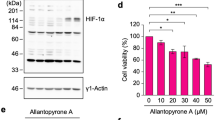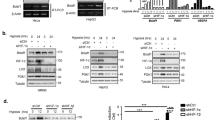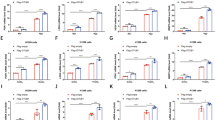Abstract
Hypoxia-inducible factor-1α (HIF-1α) is destabilized via the ubiquitin–proteasome system. Thus HIF-1α expression is robustly upregulated by proteasome inhibition, but paradoxically its activity is reduced. In the present study, we investigated the mechanism underlying the paradoxical response of HIF-1α to proteasome inhibition. In both Hep3B and HEK293 cells, a proteasome inhibitor MG132 noticeably attenuated hypoxic induction of erythropoietin and VEGF mRNAs. MG132 inactivated HIF-1α C-terminal transactivation domain (CAD), independently of factor inhibiting HIF-1 (FIH) and inhibited p300 recruitment by HIF-1α. We next tested the possibility that CITED2 is involved in the HIF-1 inactivation. CITED2 was found to be degraded via the ubiquitin–proteasome system and thus was stabilized by proteasome inhibition. Both the activity and the p300 binding of HIF-1α were inhibited by CITED2 expression and recovered by CITED2 siRNA in the presence of MG132. These results suggest that CITED2 is stabilized by proteasome inhibition and inactivates HIF-1 by interfering with the HIF-1α–p300 interaction. This may be an important mode-of-action for proteasome inhibition-based cancer therapy.
This is a preview of subscription content, access via your institution
Access options
Subscribe to this journal
Receive 50 print issues and online access
$259.00 per year
only $5.18 per issue
Buy this article
- Purchase on Springer Link
- Instant access to full article PDF
Prices may be subject to local taxes which are calculated during checkout




Similar content being viewed by others
Accession codes
References
Adams J . (2004). The proteasome: a suitable antineoplastic target. Nat Rev Cancer 4: 349–360.
Arany Z, Huang LE, Eckner R, Bhattacharya S, Jiang C, Goldberg MA et al. (1996). An essential role for p300/CBP in the cellular response to hypoxia. Proc Natl Acad Sci USA 93: 12969–12973.
Bhattacharya S, Michels CL, Leung MK, Arany ZP, Kung AL, Livingston DM . (1999). Functional role of p35srj, a novel p300/CBP binding protein, during transactivation by HIF-1. Genes Dev 13: 64–75.
Birle DC, Hedley DW . (2007). Suppression of the hypoxia-inducible factor-1 response in cervical carcinoma xenografts by proteasome inhibitors. Cancer Res 67: 1735–1743.
Braganca J, Eloranta JJ, Bamforth SD, Ibbitt JC, Hurst HC, Bhattacharya S . (2003). Physical and functional interactions among AP-2 transcription factors, p300/CREB-binding protein, and CITED2. J Biol Chem 278: 16021–16029.
Chou YT, Yang YC . (2006). Post-transcriptional control of Cited2 by transforming growth factor beta. Regulation via Smads and Cited2 coding region. J Biol Chem 281: 18451–18462.
Chun YS, Choi E, Kim TY, Kim MS, Park JW . (2002). A dominant-negative isoform lacking exons 11 and 12 of the human hypoxia-inducible factor-1alpha gene. Biochem J 362: 71–79.
Dunwoodie SL, Rodriguez TA, Beddington RS . (1998). Msg1 and Mrg1, founding members of a gene family, show distinct patterns of gene expression during mouse embryogenesis. Mech Dev 72: 27–40.
Freedman SJ, Sun ZY, Kung AL, France DS, Wagner G, Eck MJ . (2003). Structural basis for negative regulation of hypoxia-inducible factor-1alpha by CITED2. Nat Struct Biol 10: 504–512.
Harris AL . (2002). Hypoxia-a key regulatory factor in tumour growth. Nat Rev Cancer 2: 38–47.
Kallio PJ, Wilson WJ, O'Brien S, Makino Y, Poellinger L . (1999). Regulation of the hypoxia-inducible transcription factor 1alpha by the ubiquitin-proteasome pathway. J Biol Chem 274: 6519–6525.
Kaluz S, Kaluzova M, Stanbridge EJ . (2006). Proteasomal inhibition attenuates transcriptional activity of hypoxia-inducible factor 1 (HIF-1) via specific effect on the HIF-1alpha C-terminal activation domain. Mol Cell Biol 26: 5895–5907.
Koshiji M, To KK, Hammer S, Kumamoto K, Harris AL, Modrich P, Huang LE et al. (2005). HIF-1alpha induces genetic instability by transcriptionally downregulating MutSalpha expression. Mol Cell 17: 793–803.
Lando D, Peet DJ, Gorman JJ, Whelan DA, Whitelaw ML, Bruick RK . (2002). FIH-1 is an asparaginyl hydroxylase enzyme that regulates the transcriptional activity of hypoxia-inducible factor. Genes Dev 16: 1466–1471.
Liao D, Corle C, Seagroves TN, Johnson RS . (2007). Hypoxia-inducible factor-1alpha is a key regulator of metastasis in a transgenic model of cancer initiation and progression. Cancer Res 67: 563–572.
Sasabe E, Zhou X, Li D, Oku N, Yamamoto T, Osaki T . (2007). The involvement of hypoxia-inducible factor-1alpha in the susceptibility to gamma-rays and chemotherapeutic drugs of oral squamous cell carcinoma cells. Int J Cancer 120: 268–277.
Schofield CJ, Ratcliffe PJ . (2004). Oxygen sensing by HIF hydroxylases. Nat Rev Mol Cell Biol 5: 343–354.
Shioda T, Fenner MH, Isselbacher KJ . (1996). Msg1, a novel melanocyte-specific gene, encodes a nuclear protein and is associated with pigmentation. Proc Natl Acad Sci USA 93: 12298–12303.
Sun HB, Zhu YX, Yin T, Sledge G, Yang YC . (1998). MRG1, the product of a melanocyte-specific gene related gene, is a cytokine-inducible transcription factor with transformation activity. Proc Natl Acad Sci USA 95: 13555–13560.
Xu B, Doughman Y, Turakhia M, Jiang W, Landsettle CE, Agani FH et al. (2007). Partial rescue of defects in Cited2-deficient embryos by HIF-1alpha heterozygosity. Dev Biol 301: 130–140.
Yeo EJ, Ryu JH, Cho YS, Chun YS, Huang LE, Kim MS et al. (2006). Amphotericin B blunts erythropoietin response to hypoxia by reinforcing FIH-mediated repression of HIF-1. Blood 107: 916–923.
Yin Z, Haynie J, Yang X, Han B, Kiatchoosakun S, Restivo J et al. (2002). The essential role of Cited2, a negative regulator for HIF-1alpha, in heart development and neurulation. Proc Natl Acad Sci USA 99: 10488–10493.
Acknowledgements
This work was supported by a grant from The National R&D Program for Cancer Control, Korean Ministry of Health & Welfare Research Fund (no. 0520260-2).
Author information
Authors and Affiliations
Corresponding author
Additional information
Supplementary Information accompanies the paper on the Oncogene website (http://www.nature.com/onc).
Rights and permissions
About this article
Cite this article
Shin, D., Li, S., Chun, YS. et al. CITED2 mediates the paradoxical responses of HIF-1α to proteasome inhibition. Oncogene 27, 1939–1944 (2008). https://doi.org/10.1038/sj.onc.1210826
Received:
Revised:
Accepted:
Published:
Issue Date:
DOI: https://doi.org/10.1038/sj.onc.1210826
Keywords
This article is cited by
-
Hypersensitive termination of the hypoxic response by a disordered protein switch
Nature (2017)
-
Gene expression network analysis reveals new transcriptional regulators as novel factors in human ischemic cardiomyopathy
BMC Medical Genomics (2015)
-
Onconeuronal cerebellar degeneration-related antigen, Cdr2, is strongly expressed in papillary renal cell carcinoma and leads to attenuated hypoxic response
Oncogene (2009)



